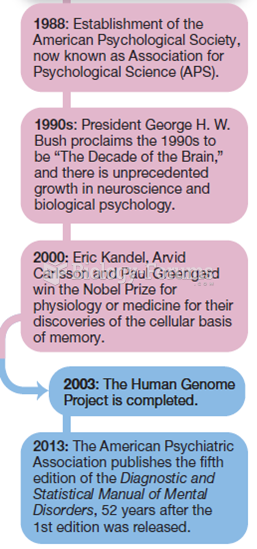Answer to Question 1
In 1970 and 1971, gay activists disrupted the conventions of the American Psychiatric Association (APA). The following year a gay psychiatrist was asked by the APA to speak, eventually leading to the establishment of a Nomenclature Task Force to review the diagnostic label of homosexuality. Ronald Gold, speaking at the 1973 APA meetings stated: Your profession of psychiatry dedicated to making sick people well, is the cornerstone of a system of oppression that makes people sick. In December 1973, the APA removed homosexuality as a diagnosis. The change in diagnostic categorization occurred in a strongly contested vote by the American Psychiatric Association. Subsequently, gay people, formerly viewed as a deviant minority and in need of treatment, were transformed into a minority who needed assistance in coping with the effects of the majority on an oppressed minority.
Answer to Question 2
Freudian theory has had a profound effect on social work's knowledge base and therefore has been a significant influence on social work practice. The link of social work and psychoanalytic theory occurred in the 1920s as Freud's concepts were being translated into English. This theoretical framework had utility for social workers in that it helped to explain intrapsychic processes and their relationship to behavior. Sigmund Freud was a psychoanalyst who theorized in his writings (from1895 to 1925 ) that the sex drive was a fundamental part of human life. Freud realized that many people had sexual conflicts. He made sexuality a central focus of his theories and defined most emotions and behaviors as being primarily sexual in nature. He interpreted sexuality broadly; he thought of it as including physical love impulses, self-love, love for parents and children, and friendship associations. Freud advanced a number of controversial theories. He asserted that everyone, from birth on, has sexual interests. He stated that boys at an early age (around age 3 ) fall sexually in love with their mother and fear their father will discover this interest and castrate them (causing castration anxiety). Girls, on the other hand, at about the same age (age 3 ) fall sexually in love with their father. They discover that they do not have a penis, and their desire to have one leads to penis envy. Girls conclude that they lost their penis at an earlier age when their mother discovered their sexual interest in their father. That is, they believe their mother castrated them because of their love for their father. Girls also experience castration anxiety, but it stems from their belief that having been castrated makes them inferior to males.
Freud's notion that sexuality was a critical part of human development initially provoked shock and outrage. Before his time, it was thought that sexual interests played only a minor role in human development. Gradually his theories came to have a liberating effect, as sexuality slowly became recognized as playing a key role in personality development. Freud's theories also led to increased communication about sexuality and stimulated scientific investigations of this topic. Freud was influenced by Plato's fable recounted above and cited it to explain the regressive character of the drives-that they seem to continually seek to return to their first expression. The fable's elements of narcissism, challenge, retribution, and attraction are also aspects of Freud's theory regarding the development of sexual orientation at the resolution of the Oedipal complex. The early followers of Freud also were equivocal regarding the nature of homosexuality. They followed the path of investigating the relationship of the Oedipus complex to homosexuality. The idea that the road to homosexuality passes over narcissism, that is, love for one's self, quoted by Sadger in 1910, became a focus to study the role of narcissism in homosexual object choice. In the years from 1930 to 1948, targeting the Oedipal and Electra complexes as central to homosexuality shifted to viewing homosexuality as derivative of the oral stage and therefore more primitive. Melanie Klein's theories of object relations became a prominent force in this debate which furthered pathologized the psychoanalytic view of homosexuality.
In postwar America, Kinsey's research studies brought sexuality into the minds of the public, including the fact that a significant percentage of young men admitted to homosexual acts at some time in their lives. In 1948 Alfred C. Kinsey, an American zoologist, published Sexual Behavior in the Human Male, which was based on interviews with 5,300 White American men. This study investigated sexual practices and found that the actual sexual behavior of males differed substantially from the stated moral values of the time. One-third of the respondents had had at least one same-sex experience since puberty; 83 had had premarital relations; half of those who were married had had extramarital affairs; and 92 had masturbated to orgasm. Five years later in 1953, Kinsey published Sexual Behavior in the Human Females, which was based on interviews with 5,940 White American women. This study showed, to some extent, that the double standard was still operating. But it also found that women were not as asexual as was commonly thought. More than half of these respondents had had premarital relations, and one- fourth of those who were married had had extramarital relations. (It should be noted that Kinsey's studies lacked racial diversity in that he studied no people of color. Therefore, any conclusions he drew can be applied to White Americans only.) Kinsey's findings were widely publicized by the mass media. For the first time, society was confronted with the wide gaps that existed between sexual mores and sexual practices. Kinsey's studies may have led people to become freer in their sexual behavior, or at least to be less judgmental about sexual behavior that was inconsistent with traditional sexual mores. The studies certainly challenged the belief that women were basically uninterested in sex.







